
"*" indicates required fields
"*" indicates required fields
"*" indicates required fields

Recent trends continue to support our forecast. However, slowing freight volumes early in Q4 make clear that the freight market recovery is only in its initial stages. We maintain that reefer equipment is further along than van, which increases near-term reefer rate volatility exposure as seasonal demand picks up ahead of the holidays.
We agree with the forecast for a muted peak season for van equipment but caution that a few pockets will likely experience challenging capacity conditions nonetheless. The gap between spot and contract rates is still large and should drive further downward pressure on contract rates into 2024.
The uncertainty around the impact of student loan repayments has not yet proved to be a cause for concern, and questions of how future interest rate trends will impact manufacturing, housing, and construction markets remain a key downside risk. If the war in the Middle East escalates further, it could prove highly disruptive to the economy, even if the impact is limited to rising fuel costs.
The capacity correction should continue, but a recent rise in new equipment orders indicates capacity may exit more slowly than previous estimates. Regardless, capacity leaving the market will make it more vulnerable to disruption, especially after another RFP season drives contract rates down closer to spot levels.
"*" indicates required fields
Slowing demand in early October indicates shippers have already moved holiday inventories into position, supporting the outlook for a softer peak season than usual.
Seasonal demand slowdowns eased rates across all three major equipment types early in the month.
Tender rejection activity below 4% for van equipment illustrates historically strong contract compliance and carriers’ continued appetite for accepting nearly all contract freight.
Elevated tender rejection rates indicate the recovery may be further along for reefer equipment and that the market may be more vulnerable to seasonal demand surges later in the quarter.
As rates have settled, the spot-contract gap for van and reefer equipment increased slightly to $0.50 and $0.49 per mile, respectively, meaning downward contract rate pressure should continue.
Large numbers of authority revocations continue; there has been a negative net change in the carrier population in 11 of the last 12 months as exits outpace new entrants.
New Class 8 truck orders surged as OEMs opened 2024 build slots; this indicates capacity may be exiting the market more slowly than previously estimated, which could push the rate recovery deeper into 2024.
The manufacturing sector was expected to be a key demand driver in 2023, but new orders just contracted for the 13th straight month, increasing potential downside demand risk.
The National Retail Federation reports strength in the retail imports forecast through the end of the year, but less so than last month. This shows that retailers are optimistic about consumer sentiment and that the inventory cycle is resetting as destocking slows; however, consumer behavior in the coming months could heavily impact 2024 trends.
Sticky inflation could lead to lasting rate elevation, limiting freight volume growth in the short to mid-term.
What’s Happening: Demand has slowed noticeably since September.
Why It Matters: Though such slowdowns are relatively normal for this time of year, current volumes support the outlook for a muted peak season.
The mid-October demand narrative is slightly less optimistic than a month ago. At the time of this writing, available indices show a pullback in recent weeks; however, this is not uncommon during the transition from late September to early October.
DAT reports exclusively on spot load trends and noted that posts were down 12.3% from August to September after increasing from July to August. The annual comps still showed a year-over-year decline, with spot load posts regressing slightly from -41.4% in August to -43.4% in September. Of additional note, spot load posts were down 15.7% from the last week of September to the first week of October, highlighting ongoing regression.
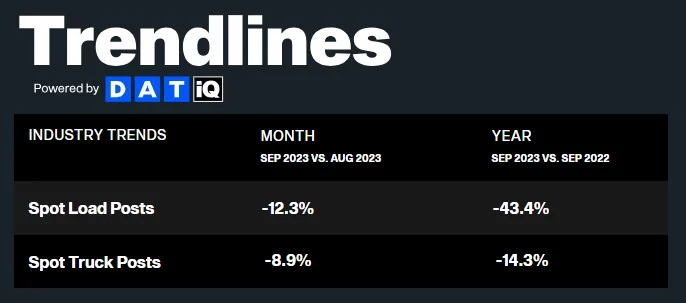
Cass reported September shipments decreased by 1.7%, which was the exact same when considering seasonal adjustment. The index remains down 6.3% year-over-year, an improvement from 10.6% in August but still a regression from the 4.7% year-over-year decline in June. Cass noted that signs are pointing to bottoming in the freight rate cycle and that ongoing carrier and OEM investment in and production of Class 8 equipment suggest a market shift may be further out on the horizon than expected.

The FreightWaves SONAR Outbound Tender Volume Index (OTVI), which measures contract tender volumes across all modes, was down 3.1% year-over-year, or 1.4% when measuring accepted volumes after the significant tender rejection rate decline.
Accepted volumes were up 0.7% month-over-month as of October 1st, driven by a 4.9% increase in accepted dry van tenders and a 5.3% decrease in accepted reefer tenders. Contrary to the spot load declines reported in DAT’s data, it makes sense to see contract volumes remain relatively stable month-over-month. It is important to note that, similar to spot trends, accepted contract tender volumes have declined into mid-October, a sign that the contract trends are moving in line with the spot market.
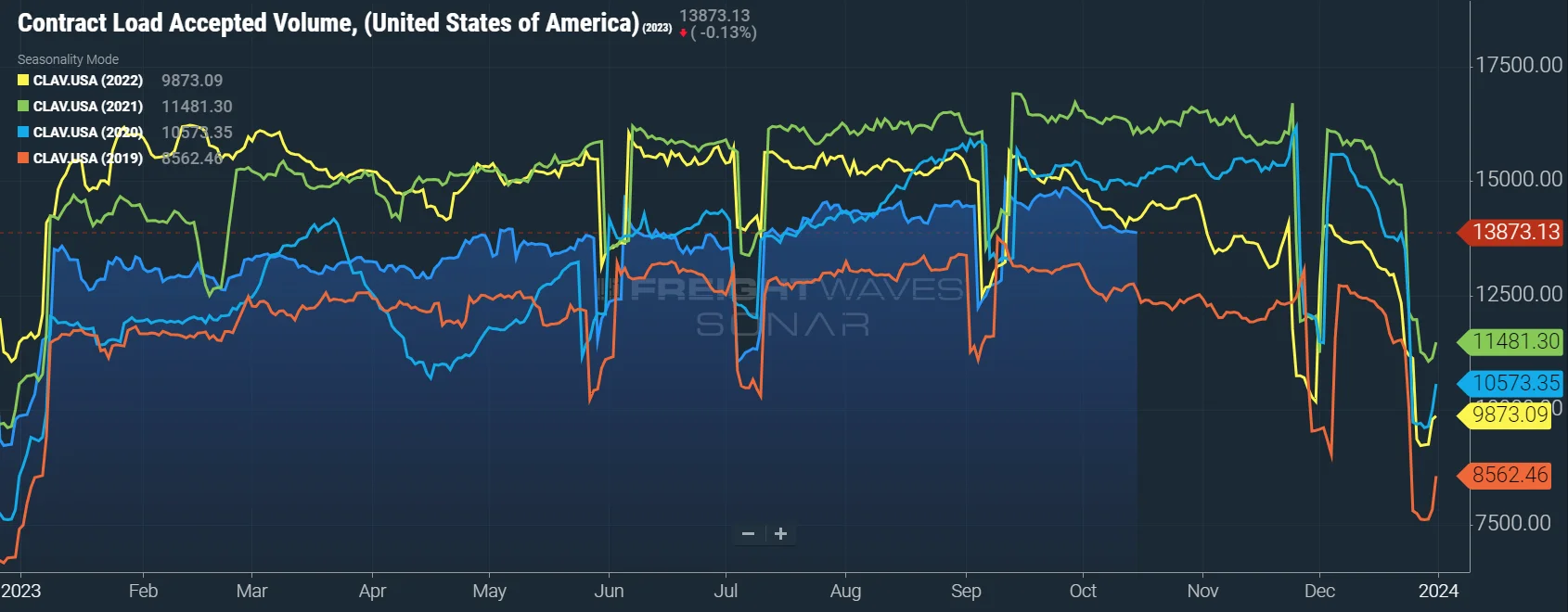
Like the reefer tender volume trends reported by FreightWaves, USDA truck shipment data for fresh fruits and vegetables showed pullbacks in total truck shipments and the year-over-year growth rate from a month ago. In mid-September, the three-week trend showed total shipments were down 3% year-over-year, with U.S.-grown shipments down 5% and imported crop shipments flat. In mid-October, the three-week trend shows total shipments are down just 1% year-over-year, with U.S.-grown shipments down 3% and imports up 1%.
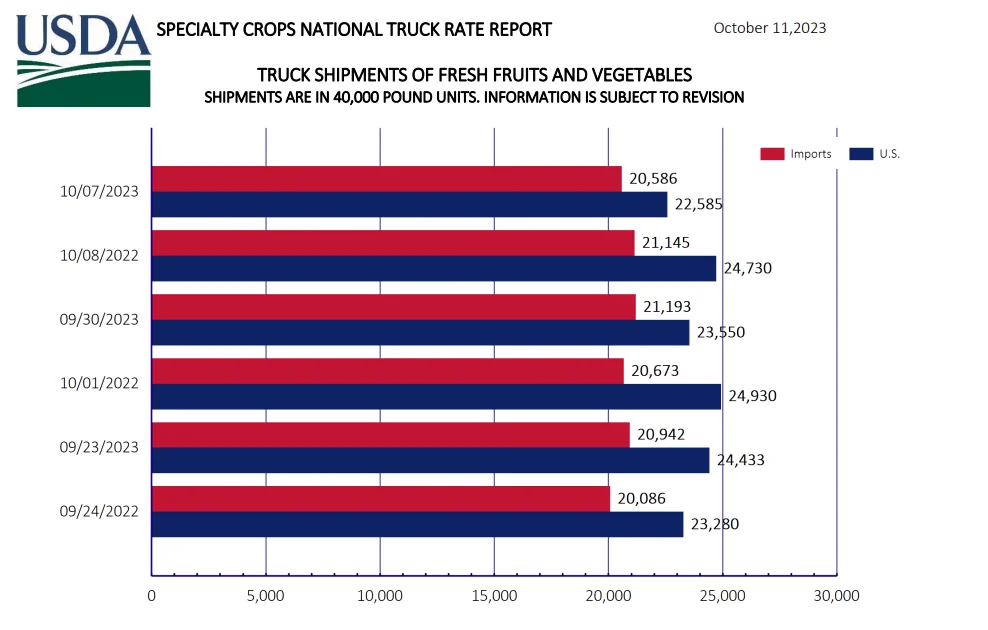
What’s Happening: While the market remains oversupplied, we can expect to see some regional reefer tightness as we approach the holiday season.
Why It Matters: Reefer tightness could present some challenges heading into the holidays.
As the lull between the summer peak season and Q4 peak retail season continues, it remains clear that capacity is largely sufficient to meet current demand. Seasonal demand surges lead to regional pockets of rate volatility throughout the summer, and this trend will likely continue through this quarter.
At a national level, conditions have eased following the consecutive impacts of Hurricane Idalia and Labor Day, though they are still not as soft as earlier in the year. This is especially true for reefer equipment, which is currently seeing tender rejections at nearly double the rate of van equipment.
The Sonar Outbound Tender Reject Index (OTRI) measures the rate at which carriers reject the freight they are contractually required to take. The numbers fluctuated between a high of 4.38% on the first day of the month and a low of 3.65% by month-end, indicating routing guide compliance on shippers’ contractual freight continually improved from already historically high levels.

Tender rejections followed a similar pattern for reefer equipment but spiked as high as 10.9% in early September and finished the month at about 8.5%. With a current value of 7.28%, it is clear that the early Q4 lull is affecting reefer equipment.
As stated a month ago, we agree with those forecasting a muted peak season as Q4 begins; however, the reefer environment could become more challenging as we approach Thanksgiving and Christmas.

The DAT Load-to-Truck Ratio measures the total number of loads relative to the total number of trucks posted on their spot board. Despite a meaningful spot load decrease, September data showed relatively flat conditions, indicating truck posts were also down.
The Dry Van Load-to-Truck Ratio was down 1.7% month-over-month and remains down 21% year-over-year, whereas the Reefer Load-to-Truck Ratio was down 22% month-over-month and 45.8% year-over-year. This may seem like a divergence from reefer contract rejection trends, but overall, easing rejections means less spot demand. So, even though reefer rejections were higher, the fact that they were dropping throughout the month is the likely culprit of declining reefer load-to-truck ratios.
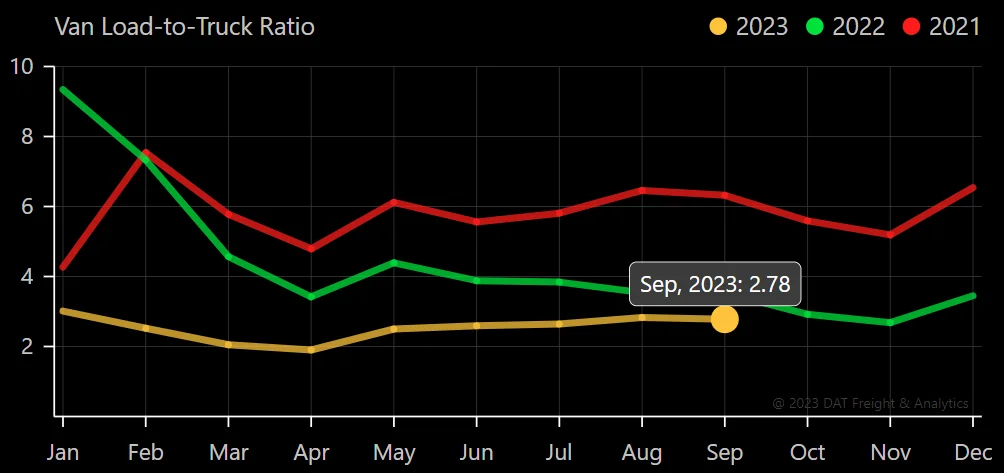

The Morgan Stanley Dry Van Freight Index is another measure of relative supply; the higher the index, the tighter the market conditions. The black line with triangle markers on the chart provides a great view of what directional trends would be in line with normal seasonality based on historical data dating back to 2007.
Conditions were relatively stable throughout September, underperforming historical seasonality and indicating supply is still largely sufficient to support demand. Historical data points to potential easing conditions through Thanksgiving before tightening through the end of the year.
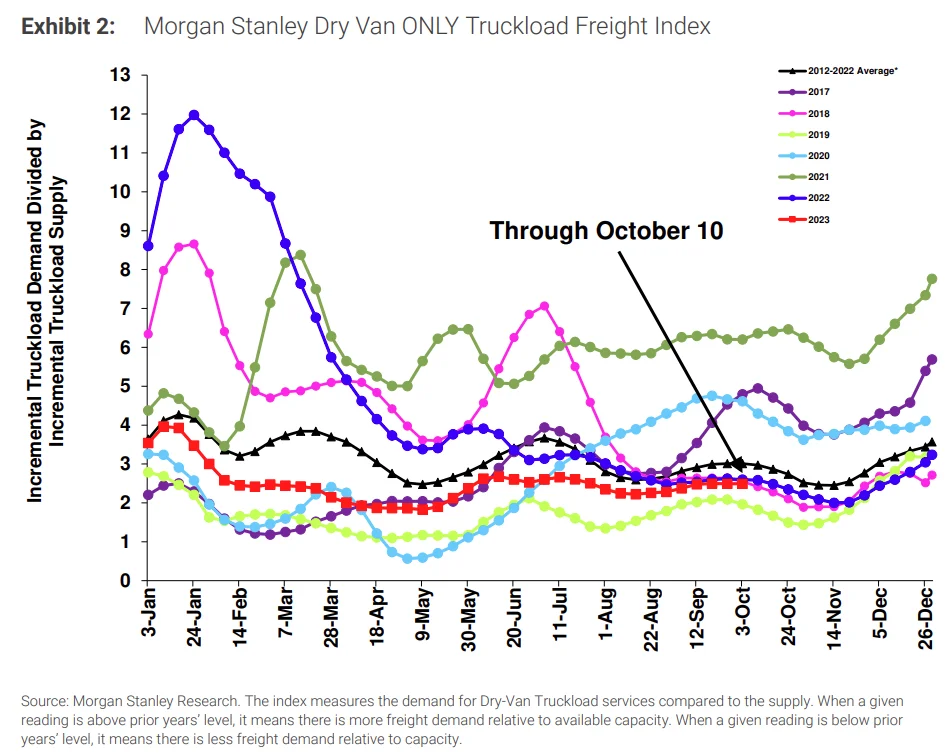

What’s Happening: Dry Van and Flatbed rates remain steady, while reefer rates see a decline for the fourth consecutive month.
Why it Matters: Rate trends illustrating steady market conditions prior to the end-of-year push.
Truckstop’s Weekly National Average Spot Rates provide a detailed view of week-to-week rate movements and a real-time look into the current rate environment.
Following tender rejection trends, rates for van and reefer equipment are showing signs of easing early in Q4, while flatbed rates appear to have found a floor. Soft market conditions should continue for all three equipment types through at least mid-November when peak retail seasonality begins.
Figure 13: Truckstop Weekly National Average Spot Rates
According to DAT, all-in spot rates, including linehaul and fuel costs, are down slightly for all three equipment types month-over-month. Since September, van and flatbed rates are down $0.01 per mile, and reefer rates are down $0.06 per mile.
Relatively stable fuel surcharges month-over-month mean that linehaul rates moved closely in line with all-in rates. That could change as the war in the Middle East threatens to disrupt oil markets.
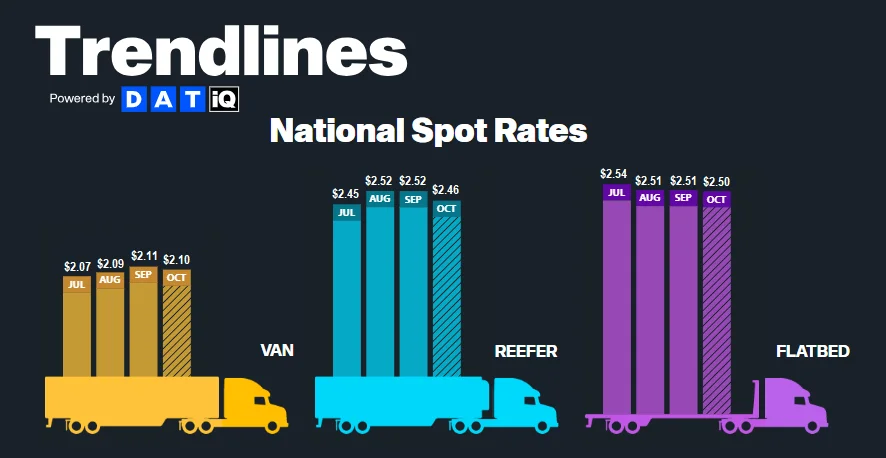
The month-over-month van rate spread increased slightly from $0.48 in September to $0.50 month-to-date in October.
All-in dry van spot rates are down 13.6% year-over-year in October, while linehaul spot rates are down 11.9%, the lowest negative growth rate since April 2022. All-in dry van contract rates are down 15.0% year-over-year, and linehaul contract rates are down 14.2%. These improvements continue to illustrate that peak deflationary pressures are behind us.
Figure 15: DAT Dry Van National Average RPM Spot vs. Contract
Monthly reefer rates fell for the fourth consecutive month, pointing to a new floor for spot rates early in October. This is a little misleading when considering the weekly rate trends, however, it still indicates that the market is in a lull typical for this time of year.
After hitting an April high of $0.58, the reefer spot-contract rate spread dipped as low as $0.41 when spot rates peaked in June but is back up to $0.49 in early October. Reefer spot rates will likely find a floor relatively quickly, enabling the gap between spot and contract rates to close again as contract rates continue to undergo downward pressure.
The current reefer contract rate is down 11.3% year-over-year to $2.36 per mile, excluding fuel, while the current reefer spot rate is down 10.1% year-over-year to $1.87 per mile, excluding fuel.
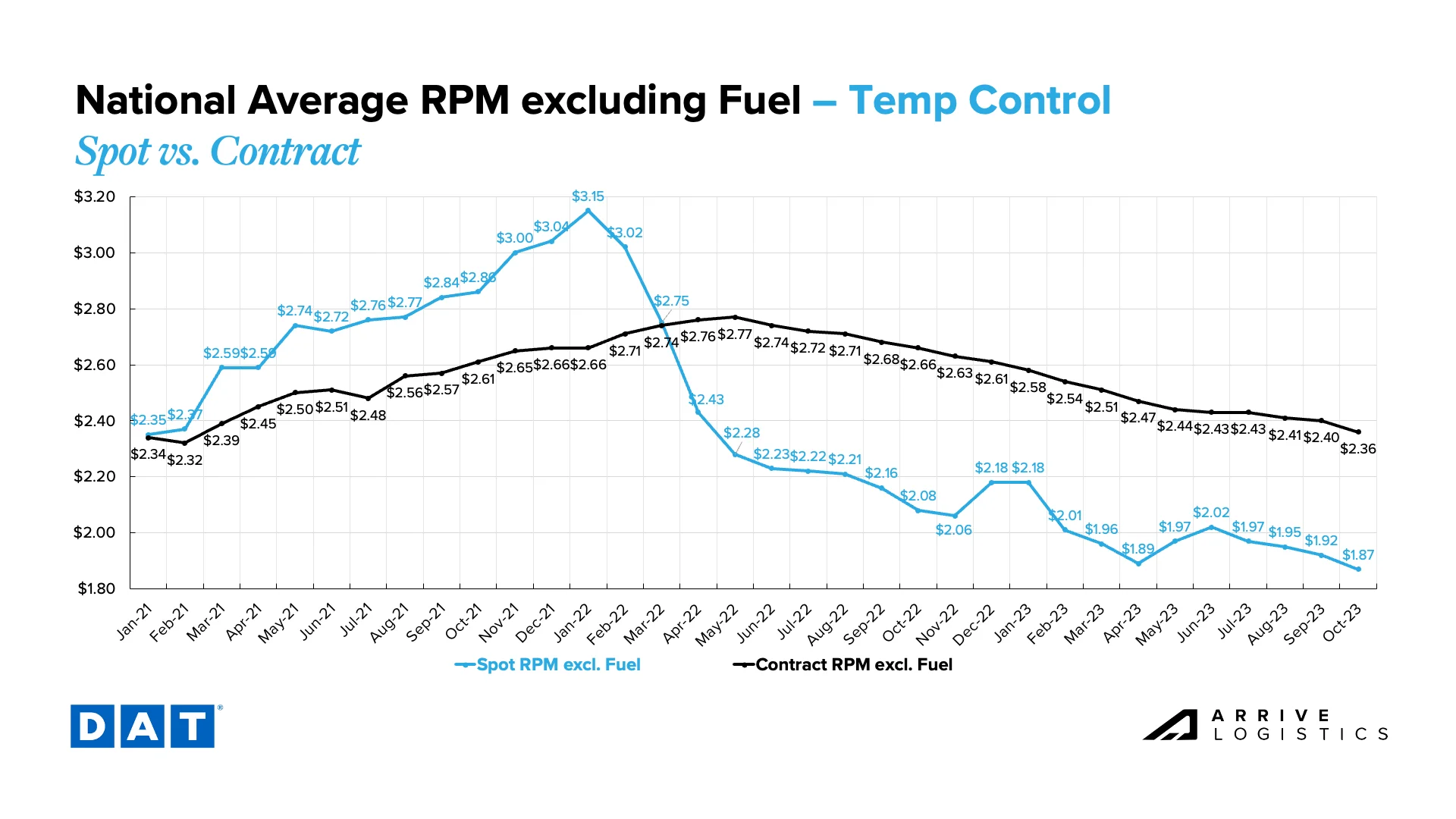
After stabilizing in the first half of 2023, flatbed rates declined rapidly from June through August and have since found a new floor. Contract rates fell at a similar rate, keeping the spot-contract gap near an all-time high of $0.66 per mile after dipping to a cycle low of $0.58 in April. In October, spot rates are currently $1.85 and contract at $2.51 per mile, excluding fuel.

What’s Happening: More than enough capacity is available to support soft demand.
Why It Matters: Rates will stay at current levels until a meaningful capacity crunch or demand surge occurs.
Freight market conditions held steady month-over-month, with minimal demand movement and a surplus of capacity driving soft conditions.
The Q4 holiday season will be relatively muted compared to previous years as wary consumers limit their spending.
Starting to see some OB tightness. Pockets of tightness are mostly localized, but could be a trend to monitor as we move further into Q4.
Pockets of localized outbound tightness are starting to appear as we move further into Q4.
Certain Canadian carriers continue to hunt for freight as the UAW strike in the United States limits automotive freight volume.
When the UAW strike ends, and backlogs are cleared, pockets of tightness may emerge and potentially result in spot market service failures.
The Canadian economy remains in flux — interest rate increases were suspended in the short term, but future meetings may lead to more hikes.
What’s Happening: A recent surge in border crossing bridge closures is creating large backlogs and long wait times in the El Paso region.
Why It Matters: Long wait times and high rates may cause shippers to seek out alternate routes.
Customers are diverting eastbound capacity through Laredo due to long crossing times through the main bridge in Ysleta-Zaragoza.
Westbound capacity may bypass Laredo and use the Tornillo or Santa Theresa bridges.
Laredo is implementing more inspections, which could lead to even longer delays as Texas authorities push for additional inspections south of the border.
The Zaragoza bridge has cleared up this week and is operating close to normal status
Long wait times are driving up rates in El Paso.
The UAW strike in the United States is leading to low volume and rates for carriers.
The start of winter weather may create northbound capacity constraints as B1 drivers tend to avoid snowy regions. This will be more impactful as protect from freeze freight demand picks up.
Demand is steady in Mexicali and Tijuana.
What’s Happening: The LTL market is strong despite economic uncertainty.
Why It Matters: Demand and rates may increase as more shippers favor LTL.
What’s Happening: The temp controlled market is following normal seasonality.
Why It Matters: Tightness is limited to certain regions.
Overall Trends
East Coast
Upper Midwest
Central Plains
Southwest
Pacific Northwest
What’s Happening: Large spike in new Class 8 truck orders as build-slots for 2024 open up.
Why It Matters: This indicates larger and private fleets are still financially healthy and could potentially lead to a slower reduction in capacity compared to previous downcycles.
Declining spot rates in early Q4 are a harsh reminder to carriers with high spot exposure that they won’t see significant market improvements for some time. Easing fuel costs are providing some relief, but risks for further fuel price volatility remain high. Although we have not yet seen revocations of operating authorities accelerate as result, we expect the lagging impact will set in later this year or early next.
Larger carriers and those running on a majority contractual basis can still operate at mostly profitable rates. They are also less vulnerable to fuel price fluctuations since contract rates are typically negotiated with a variable fuel component.
The fact that some carriers are profitable while many others are struggling makes this market cycle unique. It also makes revocation and employment data difficult to interpret due to larger asset carriers and private fleets continuing to expand their operations. That said, revocation and employment trends represent broader industry momentum swings and show an indisputable shift in where opportunity exists today.
Monthly revocations continue to ease from this year’s peaks but remain highly elevated compared to historical norms. This month, significant revocations again led to a negative net change in the carrier population. Strong contract service numbers indicate the correction is far from over, but this trend will inevitably lead to a capacity crunch, as it always does in the market cycle.
Increased operating expenses are the primary culprit causing carriers to close, as overall rates are still high compared to historical (pre-pandemic) levels. This trend continues to drive record-high revocations of authority, although October totals were the lowest in more than a year at just under 6,400 carriers.
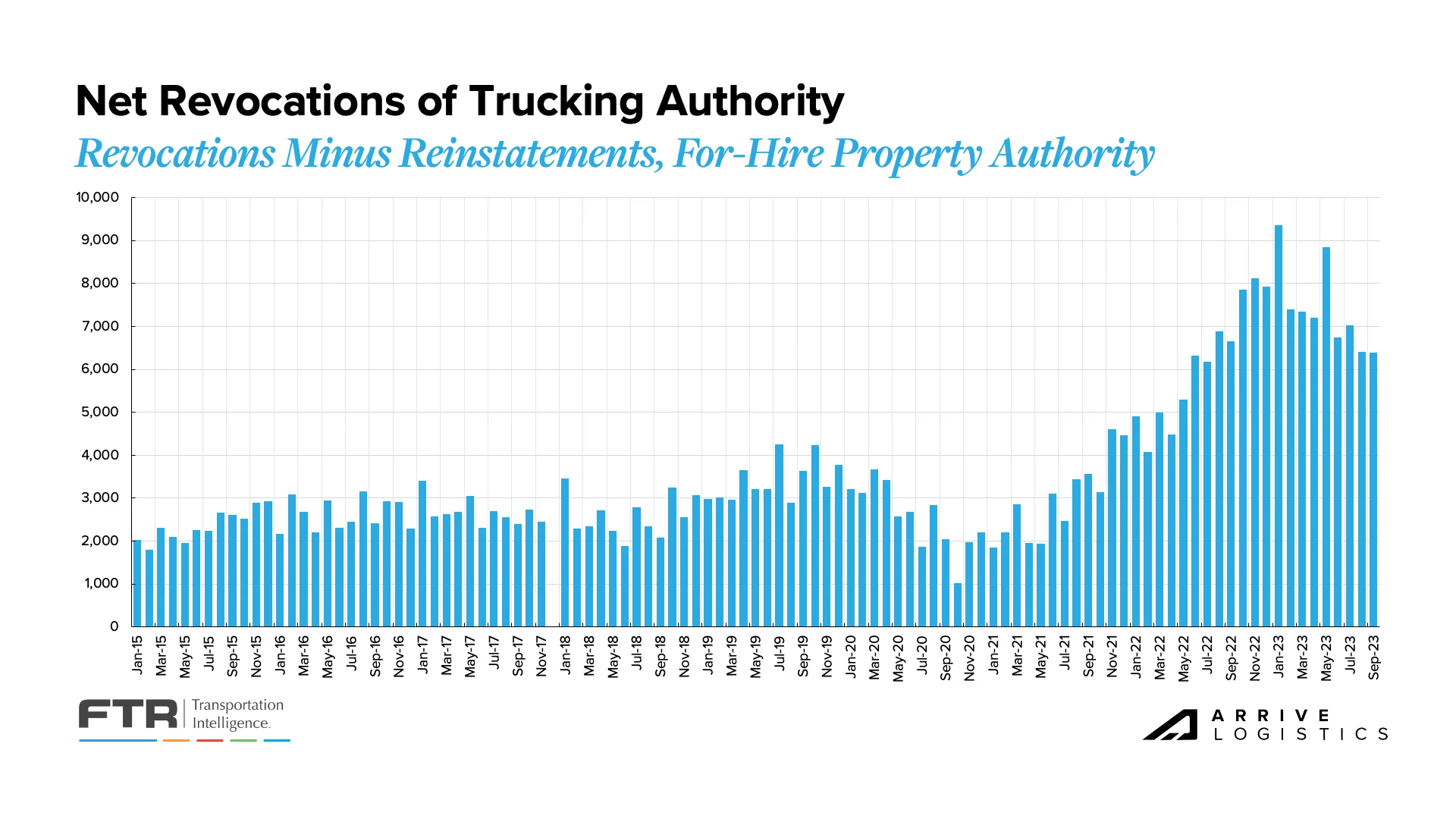
A key trend we’re still watching is revocations outpacing new carriers entering the market for 11 of the last 12 months, reducing the total number of carriers. A significant amount of capacity that entered the market over the last few years remains under-utilized, so we expect this disparity to continue for at least the near term.

New equipment orders typically slow during freight recessions, making the recent spike more intriguing. As OEM’s opened up 2024 build slots, carriers moved quickly to secure new orders. This likely points to the financial strength of larger carriers and private fleets’ ongoing investment in growth. It also represents the possibility of a much slower capacity reduction than in previous cycles. Overall, freight demand is healthy, so larger fleets are adding capacity to insource volume back from smaller for-hire fleets and owner-operators.

What’s Happening: The NRF reported consumer spending unperformed expectations and could result in lower retail import volumes.
Why It Matters: Consumer behavior through this year’s peak retail season should offer insight into retail import volumes in 2024.
Although recent October truckload demand data is discouraging, an early Q4 lull is not unusual. The broader trend shows seasonally adjusted tonnage growth since earlier in the year. This is largely due to consumer spending enabling retailers to shift from destocking to normal ordering patterns as the inventory cycle resets.
Downside demand risks remain, including concerns about manufacturing trends, how long strong consumer spending will continue, the potential impact of student loan payment resumption on 2024 housing and construction, and the possibility of an extended period of elevated interest rates.
The National Retail Federation (NRF) recently reported that while the consumer remains strong, spending growth underperformed expectations and may worsen. In turn, low retail import volumes will likely last through year-end.
Consumer behavior through this year’s peak retail season should be a strong indicator of retail import volumes in 2024. NRF Vice President Jonathan Gold said, “Cargo volumes will still be strong the rest of the year, but not as high as we expected a month ago.” This means we are unlikely to see any surprises during peak season.
If import volumes trend as expected through Q4, the 13.5% year-over-year decline in July could flip to a nearly 9% increase in year-over-year import growth by December. This gives some context to how the inventory cycle’s reset could impact demand and just how large a step back retailers took a year ago to correct their overstocked inventories.
Figure 21: NRF Monthly Imports
The latest ISM manufacturing report indicated more easing backlogs as new orders contracted for the thirteenth consecutive month amid slowing production. The new orders index contracting adds further uncertainty about future backlogs and, in turn, truckload demand. Although backlogs are contracting at an increasing rate, higher production levels indicate the sector still has pent-up demand, which should enable healthy volumes in the near term.
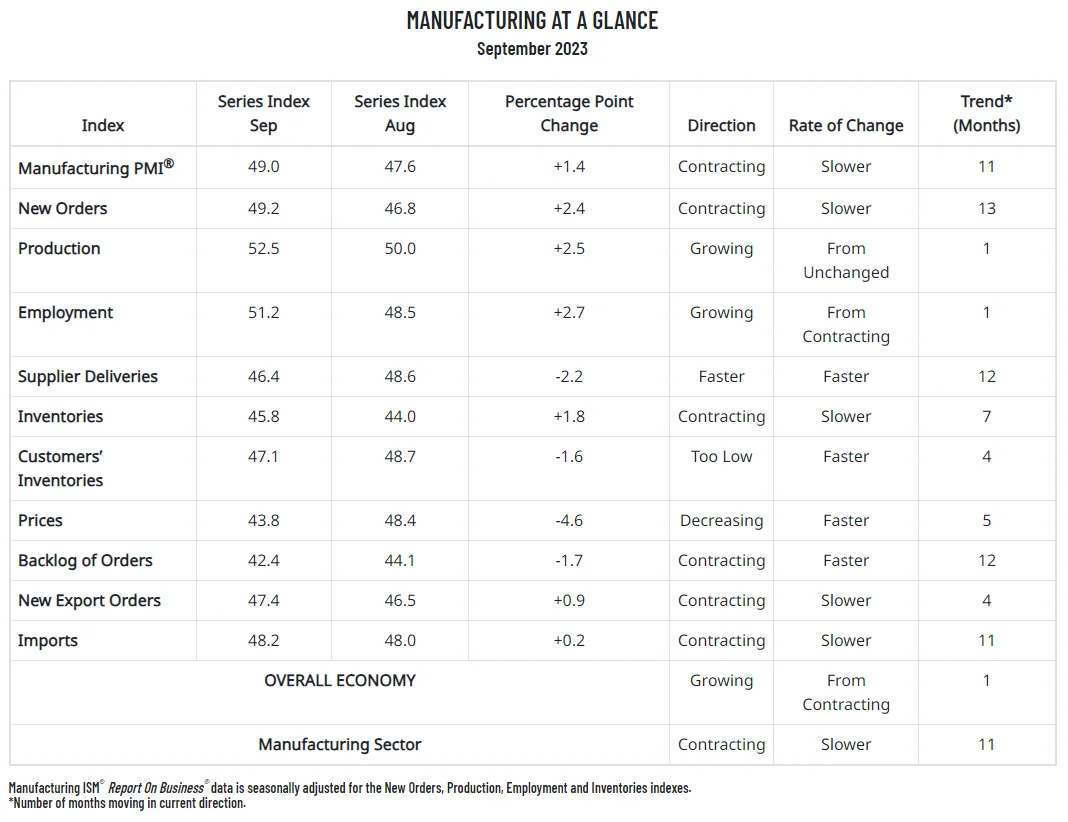
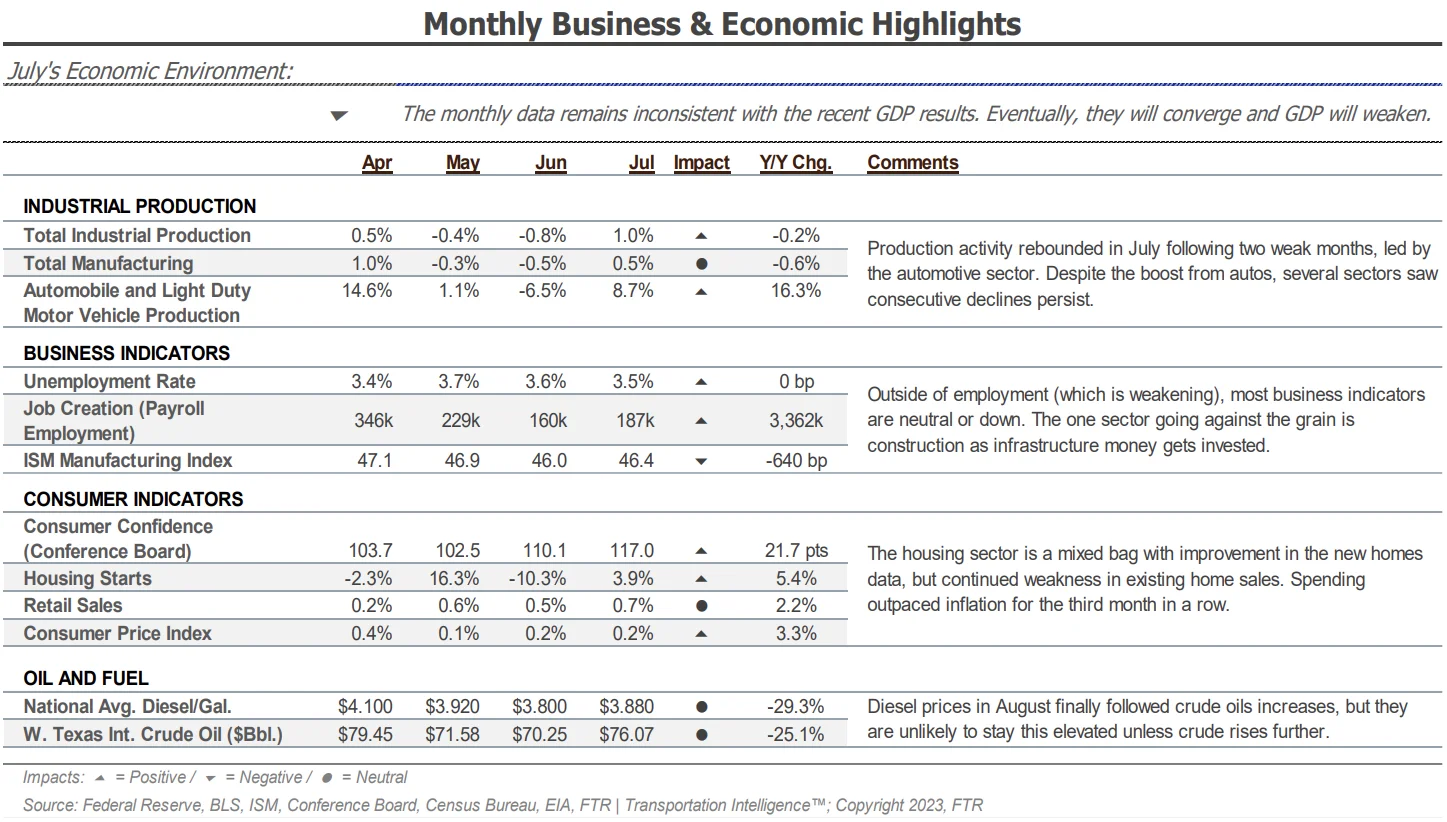
FTR’s latest truck loadings forecast for 2023 fell slightly from 0.2% year-over-year growth a month ago to 0.1%. FTR noted that the latest outlook indicates stronger activity for loadings related to construction, which offset the weaker outlook for food and bulk aggregates. The 2024 outlook revision showed growth easing from 0.9% to 0.8%, indicating a relatively unchanged perspective for the year ahead.
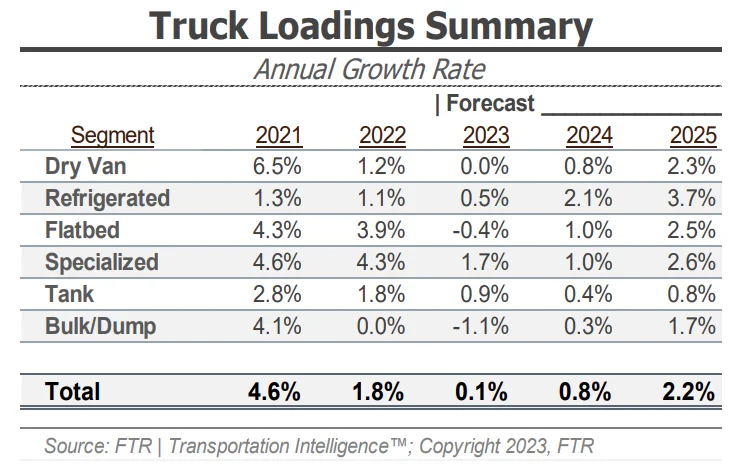
What’s Happening: Price increases have cooled, but inflation is still high.
Why It Matters: High inflation could continue to negatively impact the overall economy and the freight market into 2024.
September CPI data showed that inflation will likely remain sticky even though price increases have cooled notably. This is the concern as we look toward 2024 because while there is no direct relationship to truckload demand, it is easy to make a connection between elevated interest rates and slowing freight volumes.
It is unlikely that the Fed will lower interest rates if inflation remains above the target, leaving questions about whether the inventory cycle reset will be enough to stabilize freight volumes. But inflation eases, the Fed could lower interest rates, which could bolster housing activity and manufacturing investment — two currently slumping sectors that contribute meaningfully to freight demand.
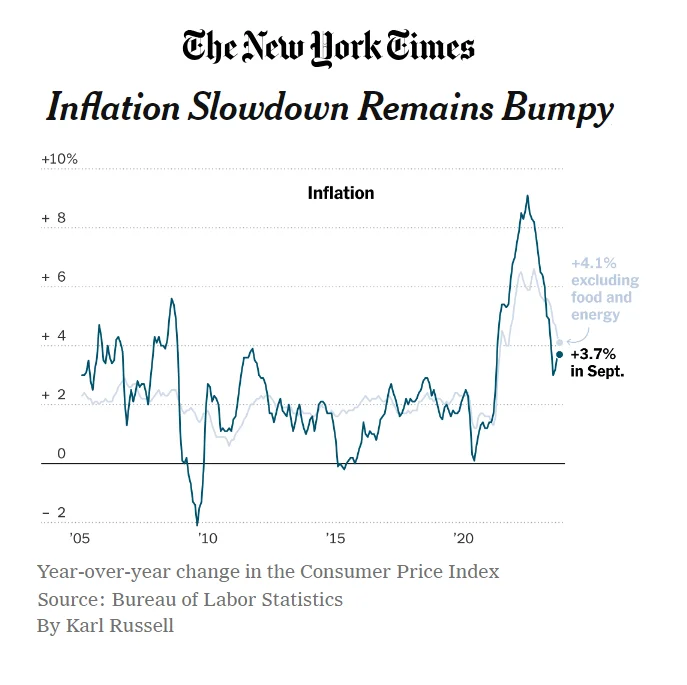
Bank of America card data showed consumer spending per household increased by 0.7% year-over-year in September, and card spending per household increased by 0.2% month-over-month on a seasonally adjusted basis. Spending was weak across most categories, particularly furniture, home improvement, and clothing. Gas spending remained strong, and spending growth at general merchandise stores and restaurants improved relative to August.
Bank of America noted that at least some of this improvement resulted from increased spending around Labor Day weekend. This is consistent with a larger bump around July 4th than normal, a sign that consumers may now be more prone to ramp up spending around the holidays, offering some hope for the Q4 outlook. They also noted that there does not yet seem to be any noticeable decline associated with the resumption of student loan repayments.
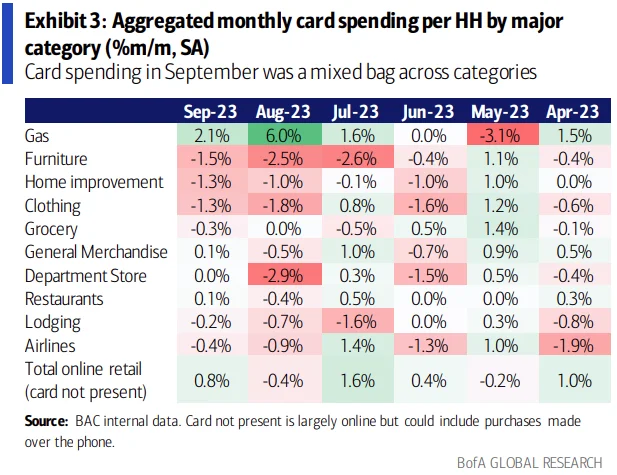
The transition into Q4 has revealed a fairly abrupt demand pullback, albeit in line with what is typical for this time of year. The slowdown doesn’t meaningfully alter our forecast. However, it does serve as a reminder that the market is still very oversupplied, especially for low seasonal demand periods, and that there is still a way to go before the market is truly vulnerable to sustained disruption.
Our viewpoint last month was that resilient consumers and slowing retail destocking support flat to stable demand growth, and supply reductions driven by high revocations of operating authority amid poor trucking conditions will leave the market more vulnerable to disruption. These assumptions have since been challenged, as the NRF lowered retail estimates through the end of the year, and new Class 8 truck orders for 2024 jumped meaningfully, signaling capacity may not be exiting as quickly as our initial estimates indicated.
While the recovery may be further along for reefer equipment, the market is behaving mostly as expected from a seasonal perspective. Recent volatility was not enough to disrupt routing guides in any meaningful way for van freight, which means that market is still mostly stable. We expect greater challenges for reefer equipment in line with seasonal demand increases around the holidays.
Our 2024 outlook is mostly unchanged. The spot-contract gap remains elevated, which should result in deflationary pressure on contract rates. However, current spot rate levels will not be sustainable for the long term, especially if fuel prices stay elevated and squeeze carrier profits.
Rising tensions in the Middle East pose a real threat of disruption, particularly to oil markets. A longer war would qualify as a black swan event with significant potential to disrupt the U.S. domestic transportation market.
We expect at least one more RFP season before contract rates drop low enough to drive market-wide exposure to prolonged routing guide disruption. In the meantime, shippers running contractual loads should see strong tender acceptance rates and service levels continue due to the oversupply of capacity, particularly on van equipment.
The market will become increasingly vulnerable to disruptive events as capacity normalizes throughout the first half of 2024, but we do not anticipate any significant disruptions in the short term.
The Arrive Monthly Market Update, created by Arrive Insights, is a report that analyzes data from multiple sources, including but not limited to FreightWaves SONAR, DAT, FTR Transportation Intelligence, Morgan Stanley Research, Bank of America Internal Data, Journal of Commerce, Stephens Research, National Retail Federation and FRED Economic Data from the past month as well as year-over-year. We know market data is vital in making real-time business decisions. At Arrive Logistics, we are committed to giving you the data and insights you need to better manage your freight.

